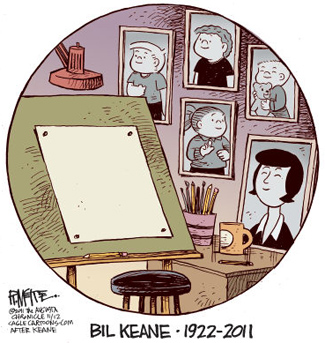 Tom Wicker was more
than a great reporter, he was a progressive thinker who dared tread close to
the line that separates impartial journalism from outright activism – at
a time when it was far less common than it is today. During his three-decade
career at The New York Times that ended in 1991, he was a powerful voice in civil
rights and anti-war movements, speaking from a perch that gave him clout with
presidents as well as millions of Americans. Tom Wicker was more
than a great reporter, he was a progressive thinker who dared tread close to
the line that separates impartial journalism from outright activism – at
a time when it was far less common than it is today. During his three-decade
career at The New York Times that ended in 1991, he was a powerful voice in civil
rights and anti-war movements, speaking from a perch that gave him clout with
presidents as well as millions of Americans.
In 1971, after writing about unacceptable prison conditions nationwide, Wicker
found himself part of the story at Attica prison in upstate New York. He agreed
to join a negotiating team during an uprising by inmates, and wound up watching
in horror as 29 prisoners and 10 hostages died in an assault by state troopers
and guards.
Wicker wrote “A Time to Die” about his experience, and many believe
it was the best of his 20 books. Ten years later it was made into a movie by
ABC. The Times assigned me to interview Wicker and the filmmakers to find out
why the movie was relatively soft while the book was so hard-hitting.
Wicker explained that, in print, “I was able to (present) a number of
things involving the problems of criminal justice in America, racism and violence
in America.” Film, he told me, “doesn’t work very well that
way.” Tom Wicker was a print guy all right, at a time when that was the
most important thing a journalist could be.
Andy Rooney not only entertained us, he made us think – not about big,
complicated matters but about little things that knit to form our lives. “Curmudgeon” was
a word several writers used to describe him. Having been his neighbor in Connecticut
I can confirm that he was as grouchy at the hardware store as he was on “60
Minutes.”
What intrigued me most about Rooney was his ability to notice things in life
that many of us tend to overlook, and his relentless pursuit of society’s
peccadilloes. Andy Rooney was the type of journalist who had the canny ability
to make us think while also making us smile.
Hal Bruno was not a household name, but as chief of political coverage for
ABC News, where I worked for five years, he helped develop the type of analysis
and numbers-crunching that we now take for granted.
He moderated several notable debates, including the vice presidential confrontation
between Al Gore and Dan Quayle. Unlike today’s televised debates in which
moderators increasingly seek to egg on candidates with gotcha questions, Hal
Bruno was a master of the low-key, studious approach aimed at eliciting great
answers rather than just good TV.
Bil Keane’s work appeared in the comic section, but it managed to trigger
our emotions as much as anything on the front page. “The Family Circus,” a
simple panel with parents and kids who haven’t aged a bit since its debut
in 1959, remains a staple in over 1,500 newspapers.
It’s schmaltzy yet real, as when one tot asks his mother, “Can
I wear my short-sleeve pants?” Or when another exclaims, “Mom’s
cooking my favorite dinner. It’s called leftovers.”
I never met Bil Keane, but often felt he was part of my family. Beginning
in 1954 he drew a comic panel called “Channel Chuckles,” for which
one of his favorite subjects seemed to be my father’s program, “Candid
Camera.” As always, the humor was pointed, yet kind. Bil Keane’s
real-life son, Jeff, has been helping with “Family Circus” for some
time, so the institution will continue – a passing of the media torch with
which I’m familiar.
Taken together, the work of these four men provides a good picture of what
great journalism can be, regardless of the form it takes or the era in which
it is practiced.
(c) Peter Funt. This column was originally distributed by the Cagle syndicate.
|



 Tom Wicker was more
than a great reporter, he was a progressive thinker who dared tread close to
the line that separates impartial journalism from outright activism – at
a time when it was far less common than it is today. During his three-decade
career at The New York Times that ended in 1991, he was a powerful voice in civil
rights and anti-war movements, speaking from a perch that gave him clout with
presidents as well as millions of Americans.
Tom Wicker was more
than a great reporter, he was a progressive thinker who dared tread close to
the line that separates impartial journalism from outright activism – at
a time when it was far less common than it is today. During his three-decade
career at The New York Times that ended in 1991, he was a powerful voice in civil
rights and anti-war movements, speaking from a perch that gave him clout with
presidents as well as millions of Americans.